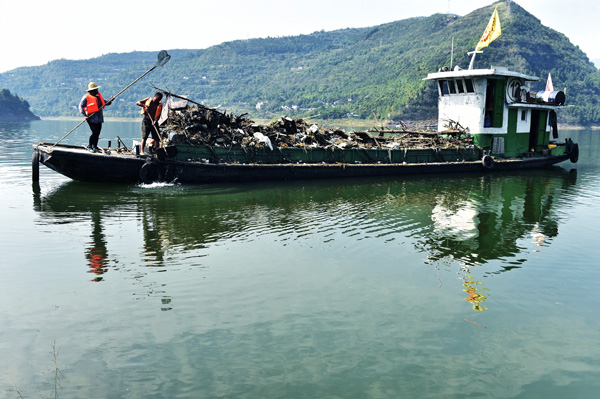 |
Workers remove floating objects from the Xiaojiang River, a tributary of the Yangtze River, in Chongqing in October. [Photo by Rao Guojun/For China Daily] |
It is just one example of President Xi Jinping's environmental protection and eco-civilization philosophy.
China has a long history of water control and management. In ancient times, the administrators appointed special officials in charge of river affairs. During the Warring States Period (475-221 BC) governor of Shu prefecture Li Bing, ordered the building of the Dujiangyan Irrigation System in today's Sichuan province in Southwest China, which is a famous example of water conservancy and could be regarded as the precursor of the river chief system.
The river chief system today is a management system for rivers and lakes and is linked to the accountability system of environment protection and performance evaluations of top officials. It was first implemented in Wuxi, East China's Jiangsu province, in 2007 to solve the algae problem in Taihu Lake. Wuxi municipal authorities made the local chiefs at different levels the river chiefs, too, giving them the full responsibility of water and environmental management. The move proved a big success, as algae pollution is now a thing of the past.
In 2012, the Jiangsu provincial authorities extended the river chief system to cover the entire province. The next year, the Zhejiang provincial authorities implemented it. And in 2015, the Ministry of Water Resources launched pilot river chief system programs nationwide.
Although governments at all levels have made great efforts to control water pollution, the condition of China's water bodies has worsened over the past four decades. The quality of water in one-third of China's rivers is below the third level of the national water quality standard, mainly because local governments have failed to strike the right balance between economic development and environmental protection. Local governments used to sacrifice the environment for economic growth, and water management suffered from a lack of coordination.
Comprehensive water management calls for unified management and control, but in reality environmental protection departments are in charge of tackling water pollution while water resources departments are responsible for managing water bodies. The river chief system is expected to break through this institutional barrier and build a unified management and control system.
At the core of the river chief system is river and lake management, which is the responsibility of government heads. The river chief system will be established at the provincial, municipal, county and township levels, and the government heads of every province, autonomous region and municipality, by default, will be the general river chiefs. Besides, mayors and county heads will be responsible for the protection of water bodies in their administrative regions.
The river chief system is a provincial-level unified management system that will facilitate better coordination among departments and thus strengthen water management. The system also has provisions for involving the public in water management and supervision through modern network technology and reporting platforms, which is an excellent example of China's social management.
By making the Party chief the top water management official, too, in his or her administrative area, the authorities have ensured that the Party's advantages in terms of leadership and foresight are used to better protect the water bodies. Also, the system provides a mechanism for cross-regional water management by clearly defining a river's divisions into different administrative zones.
To fully implement the river chief system nationwide, local authorities have to make sure the system operates as part of the current water management system. And the system would function more smoothly if the river chief directly coordinates with relevant departments to ensure rivers and lakes get full protection against pollutants and polluters.
 |
The author is a researcher at the Institute of Geographic Sciences and Natural Resources Research, Chinese Academy of Sciences. |






